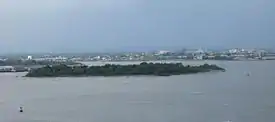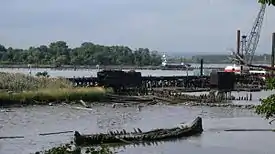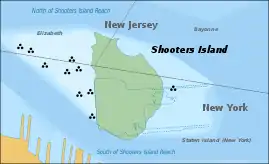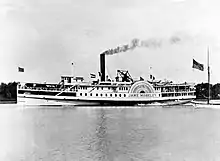40°38′36″N 74°09′35″W / 40.64333°N 74.15972°W



Shooters Island is a 43-acre (17 ha) uninhabited island at the southern end of Newark Bay, off the North Shore of Staten Island in New York City.[1] The boundary between the states of New York and New Jersey runs through the island, with a small portion on the north end of the island belonging to the cities of Bayonne and Elizabeth in New Jersey and the rest being part of the borough of Staten Island in New York City.
In colonial times Shooters Island was used as a hunting preserve. During the Revolutionary War, George Washington used the island as a drop-off point for messages, and the place became a haven for spies.[2]
Following the war, the island's large oyster beds were heavily harvested, ultimately exhausted from over harvesting.[2]
Shipyard

_in_boat_basin_at_Shooters_Island%252C_circa_1936.png.webp)
The first shipyard on Shooters Island was established in 1860 by David Decker.[2] From 1898[3] until 1910, the island was home to a major shipyard, the Townsend-Downey Shipbuilding Company. Theodore E. Ferris, who later designed ships used by the American government in World War I, was an employee of the firm.[4] Around this time it was also home to the Standard Shipbuilding Company, which bought the island in 1915.[3] The entire island was occupied by buildings, including a foundry, pattern shop, and offices. There were major docks and shipways that faced to the east.
The Townsend-Downey Company built a yacht, Meteor III, for Kaiser Wilhelm II of Germany. Its launch in February 1902 was attended by many hundreds of spectators, including Pres. Theodore Roosevelt and Prince Henry of Prussia. Alice Roosevelt, the president's daughter, christened the boat. Thomas Edison sent a cameraman who made one of the first news movies of the event. It is available online from the Library of Congress.[2][5] The next day a reception was held at the White House for Mr. Downey and representatives of the German Government.[2]
The following year the fast three-masted schooner Atlantic was launched at the yard. In 1905, it raced across the Atlantic and won the Kaiser's Cup and set a record for the crossing under sail which stood unbroken for almost 90 years. The brigantine yacht Carnegie was built for the Carnegie Institution of Washington for use in magnetic surveys in the Pacific Ocean. Constructed entirely of wood and nonferrous metals so as not to interfere with magnetic measurements, she was named after industrialist and philanthropist Andrew Carnegie, a friend of Mr. Downey.[2]
The island came under the control of the Tidewater Oil Company in 1903.[6] In 1905, the eight building plant and its 33 acres were purchased by the Colonial Trust Company for $516,000. At the time, the shipyard was valued at two million dollars.[7]
The island was used for industrial and shipbuilding operations through 1922. Abandoned vessels began to accumulate around the perimeter of the island by 1930.[8]
Bird sanctuary
Shooters Island began to support nesting wading birds, cormorants and gulls in the early 1970s. At its peak in 1995, the island supported 400 nesting pairs of herons, egrets, ibis and 121 nesting pairs of double-crested cormorants. The island is now owned by the City of New York and is maintained by New York City Department of Parks and Recreation as a bird sanctuary.[9]
The island and decayed remnants of old piers are visible to users of the Bayonne Bridge between Staten Island and Bayonne, New Jersey.
See also
References
- ↑ Berger, Joseph (December 4, 2003). "So, You Were Expecting a Pigeon?; In City Bustle, Herons, Egrets and Ibises Find a Sanctuary". The New York Times. Retrieved August 21, 2007.
The 43 acre Shooter's Island is between Newark Bay and the Kill Van Kull in a channel favored by cargo ships and tankers. Yet as the city began filtering its sewage in the 1970's and taking other steps to clean its waterways, wading birds began cropping up on the island.
- 1 2 3 4 5 6 "Shooter's Island". New York City Department of Parks and Recreation. Retrieved July 29, 2008.
In colonial times Shooter's Island was used as a hunting preserve. Its role changed during the Revolutionary War (1775–1783), as George Washington used the island as a drop-off point for messages, and the place became a haven for spies. Following the Revolutionary War, the island's large oyster beds were harvested so frequently that they were soon exhausted from over harvesting. In the late 1800s, the island saw human interest on a large scale.
- 1 2 Cooke, Charles; Maloney, Russell (July 2, 1938). "Shooter's Island". New Yorker. ISSN 0028-792X. Retrieved May 23, 2019.
- ↑ Weiss, George (1920). America's Maritime Progress. New York Marine News Company. pp. 151–152.
- ↑ "Arrival of Prince Henry (of Prussia) and President Roosevelt at Shooters Island". Thomas A. Edison. 1902.
- ↑ "BIG SHIPYARD SHUTS DOWN; Unexpected Action Taken by Town- send-Downey Company. Notice Posted That Work Will Be Re- sumed Monday -- Standard Oil In- terests May Control". The New York Times. November 28, 1903.
- ↑ "Shipyard Sold". New-York Tribune. New York. March 15, 1905. p. 3. Retrieved August 13, 2015.
- ↑ Record, Historic American Engineering. "Shooters Island, Ships Graveyard, Newark Bay, Staten Island (subdivision), Richmond County, NY". www.loc.gov. Retrieved January 17, 2020.
- ↑ Parsons, K. and B. Wright. 1995. Aquatic Birds of New York Harbor: 1995 Management Report. Unpublished report. New York City Audubon, New York, NY.
External links
- NYC Audubon Harbor Herons Project
- Harbor Herons Nesting Survey, recent reports on wading bird, cormorant, and gull nesting activity at and around Shooters Island
- History of Shooters Island
- Historic American Engineering Record (HAER) No. NY-162, "Shooters Island, Ships Graveyard, Newark Bay, Staten Island, Richmond County, NY", 6 photos, 1 measured drawing, 50 data pages, 1 photo caption page
- HAER No. NY-162-A, "Shooters Island, Ships Graveyard, Vessel No. 37", 8 photos, 2 measured drawings, 3 data pages, 1 photo caption page
- HAER No. NY-162-B, "Shooters Island, Ships Graveyard, Vessel No. 53", 6 photos, 1 measured drawing, 8 data pages, 1 photo caption page
- HAER No. NY-162-C, "Shooters Island, Ships Graveyard, Vessel No. 54", 5 photos, 1 measured drawing, 3 data pages, 1 photo caption page
- HAER No. NY-162-D, "Shooters Island, Ships Graveyard, Vessel No. 84", 2 photos, 1 measured drawing, 3 data pages, 1 photo caption page

